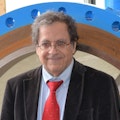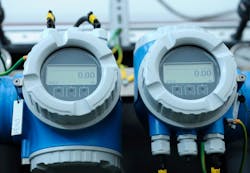Key Highlights
- Primary elements work with DP transmitters to form DP flowmeters by creating a pressure drop in the flow line.
- The difference between upstream and downstream pressures is used to calculate flowrate.
Primary elements are used with differential pressure (DP) flow transmitters to create DP flowmeters. Primary elements place a constriction in the flow line that creates a pressure drop in the line. The DP transmitter uses the difference between upstream pressure and downstream pressure in the line as a basis for computing flow.
Here are the main types of primary elements:
- Orifice measuring points
- Pitot tubes
- Venturi tubes
- Cone elements
- Flow nozzles
- Wedge elements
Orifice plates
Orifice plates are the most common type of primary element. An orifice plate is a flat, usually round piece of metal, often steel, with an opening in it. The orifice plate needs to be positioned at a correct position in the flowstream for it to function as a primary element for the purpose of making a differential pressure flow measurement. To be in position, it must be held in place, which is typically done by an orifice assembly, an orifice flange or a holding element.
Pitot tubes
The Pitot tube is named after Henri Pitot, who invented it in 1732. Pitot tubes are of two types: single-port and multiport averaging Pitot tubes.
A single-port Pitot tube includes an L-shaped tube measuring impact pressure. The tube is inserted into the flow stream with the opening facing directly into the flow. Another tube measuring static pressure has an opening parallel to the direction of flow. Flowrate is proportional to the difference between impact pressure and static pressure.
A multiport averaging Pitot tube has multiple ports to measure impact pressure and static pressure at different points. The DP transmitter computes flowrate by taking the average of the differences in pressure readings at different points.
Venturi tubes
A Venturi tube is a flow tube that has a tapered inlet and a diverging exit. The DP transmitter measures pressure drop and uses this value to calculate flowrate (Figure 1).
The Venturi tube was invented by an Italian physicist named Giovanni Battista Venturi in 1797. In 1887, Clemens Herschel used Venturi’s work to develop the first commercial flowmeter based on it. His version of the Venturi flowmeter became known as the Herschel Standard Venturi. Herschel published his paper called “The Venturi Water Meter” in 1898. In 1970, a company called BIF introduced the Universal Venturi Tube.
Cone elements
Cone meters have been around since McCrometer Inc. developed and patented the first successful model, its V-Cone in 1985.
Cone meters consist of a specially tapered element positioned within the flowstream to create a restriction to the flow through the pipe. Some cones are held in place by a tube that also connects it to the outside of the pipe. In the even more compact wafer cone design, the element is fastened in place with an attached bar that spans the pipe diameter. The cone element creates a difference in speed and pressure as the flow is forced around it, then allowed to resume unobstructed flow beyond the cone.
Flow nozzles
A flow nozzle is a flow tube with a smooth entry and a sharp exit. With elegant simplicity, the restriction caused by the reductions in diameter within the nozzle creates measurable changes in the flow through it, but the smooth, tapered shape causes less permanent pressure loss than an orifice plate. The DP transmitter computes flowrate based on the difference between upstream pressure and downstream pressure.
Get your subscription to Control's tri-weekly newsletter.
Wedge elements
A wedge element is a flow tube that has a V-shaped flow restriction—the wedge—protruding into the flow stream from at least one side of the pipe. The wedge might be attached and contained inside the pipe or it might be created by heavy sections of metal welded into a notch cut in the pipe. Wedge elements can handle any type of flow profile, whether laminar, transitional, or turbulent, and they are less prone to clogging or build up than some other element types.
The following are frontiers of research for primary elements.
Technology improvements in primary elements
Primary elements suppliers continue to develop technological improvements, many of which are created as solutions to rather discrete application problems. For example, primary flow signal stocks and supplies a number of different Venturi elements, many of which have been developed for a specific level of performance addressing customer applications that were not previously considered applicable for DP measurement.
Dosch Messapparate now includes averaging Pitot tubes that conform to ISO 5167 in its primary element portfolio as well as cone meters and wedge elements. Canalta Controls offers single- and dual-chamber housings that ease the task of flow conditioner inspections and make these inspections more cost effective. Another addition to Canalta Controls’ product line is an orifice fitting kit, which is designed to allow for a complete rebuild of the orifice fitting or to replenish spare parts as needed.
Developing more types of orifice plates
Emerson and other companies have brought out new types of orifice plates in the past five years, and this remains an area for further research. Types of orifice plates include concentric, eccentric, segmental, and quadrant edge orifice plates. In addition, conditioning orifice plates reduces the need for upstream piping. In some cases, these are offered with integrated pressure transmitter to form an integrated DP flowmeter.
Materials of construction are an important part of the effectiveness of orifice plates. Materials such as nickel and Monel make the plates more corrosion resistant. The different designs of the orifice plates can enhance accuracy and can also make the plate less susceptible to clogging by suspended particles in the flowstream. Even though orifice plates are probably the most studied type of primary element, new materials and new designs are a frontier of research for these very traditional forms of measurement.
Combining different types of primary elements
While most types of primary elements fit into a single category, some companies have combined two types of primary elements into a new type of primary element.
Armstrong Veris offers the Accelabar, which is a combination of a flow nozzle and an averaging pitot tube. VorTek has introduced the VorCone, which combines elements of a vortex flowmeter, with elements of a cone meter. The tests and results on VorCone are very positive. This combination of technologies makes it possible to predict fluid density, volumetric flowrate, and mass flowrate without making use of any fluid density information from an external source. Among other benefits, this combination of technologies makes it possible for VorCone to calculate the changing densities of gas mixtures.
While these are two examples, this is hardly the end of the story. Combining two technologies together can help compensate for the weaknesses of a technology and enable it to address a broader range of applications. For example, vortex meters have a difficult time measuring low flows, since if flow is low enough, the bluff body in the vortex meter will not generate the vortices required for a flow measurement. Pairing a vortex meter with a thermal meter could result in a meter that could handle medium to high flows and excel at low flow measurement. While this is one theoretical example, there are no doubt other possibilities that will continue to be researched by innovative flowmeter companies.
About the Author

Jesse Yoder
Columnist
Jesse Yoder is founder and president of Flow Research Inc., which conducts market research studies in a wide variety of areas, including the flowmeter market.

Leaders relevant to this article:
